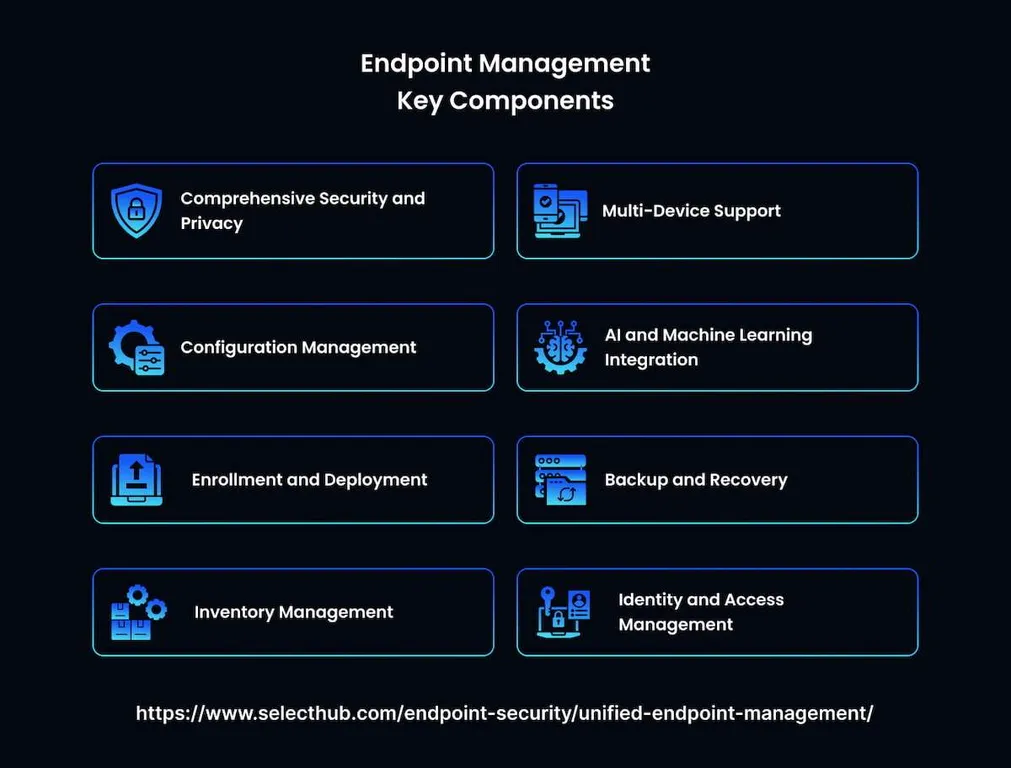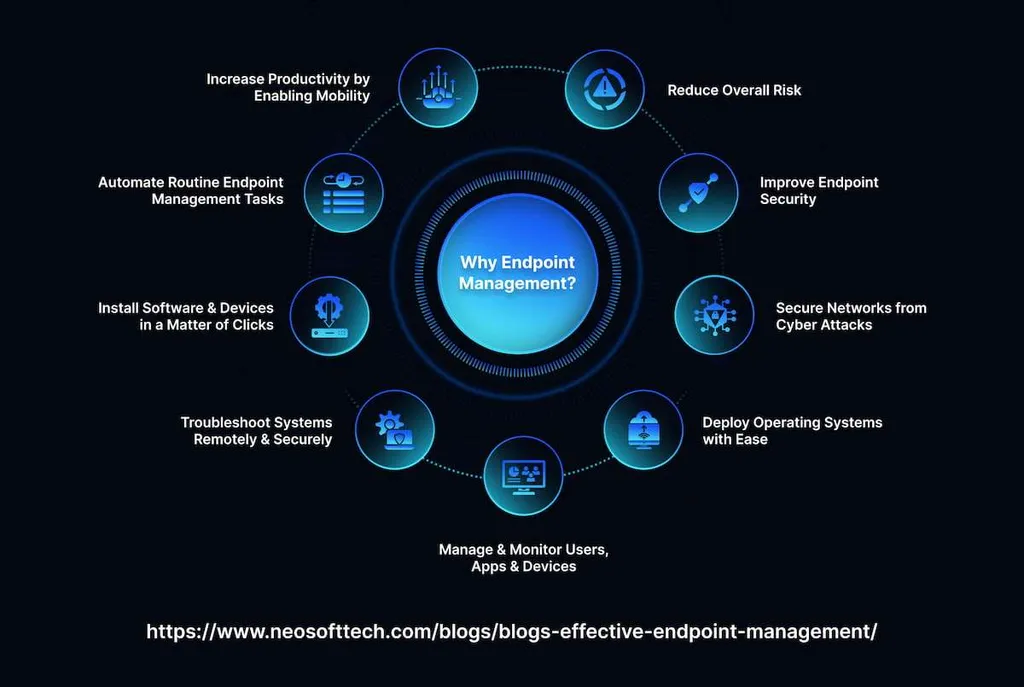IT teams have to navigate complex environments when working on their projects. As the number of elements within a single network increases, professionals must discover a new way of controlling thousands of nodes and fixing security-related problems quickly and efficiently. Automated endpoint management (AEM) allows them to release updates, enhance functionality, and boost productivity. In our guide, we’ll consider how enterprises use this method to streamline routines, simplify decision-making, reduce operational expenses, and respond to digital threats automatically.
What is AEM?

This is an innovative approach based on AI technologies that allows businesses to handle devices within a network. Companies adopt it to automate tasks and ensure autonomous handling of multiple endpoints. Dedicated tools are built to monitor processes, diagnose issues, and find solutions. IT professionals deploy them to simplify operations and reduce workload.
Enterprises implement new and time-tested strategies to augment security, optimize device functioning, and adhere to industry regulations without manually controlling every operation. AI-powered tools analyze access points and discover the best way to respond to problems they detect. They release patches, adjust settings, and perform other tasks independently.
Algorithmic features allow businesses to create complex policies, build powerful frameworks, implement the best governance practices, and fine-tune the functioning of autonomous tools depending on current needs. It permits IT professionals to foster innovation and invent something new instead of being overloaded with procedures.
While traditional strategies rely on manual input and involve reacting to the problems that have already manifested, AEM permits enterprises to avoid delays by eliminating issues proactively. It lets companies resolve problems without human intervention. Traditional solutions are quite time-consuming, as it might take IT teams a while to update software, apply patches, and analyze device health. Large businesses may face significant delays due to such inefficiencies. Automation reduces time spent on updates and other tasks.
Companies no longer need to struggle when trying to scale processes. When the number of devices increases, automated bots manage thousands of terminals with little to no effort. As a result, systems become increasingly scalable. It makes it easier to maintain hybrid work environments with devices located in different parts of the world.
Until recently, IT professionals had to address issues with devices after they had already become quite noticeable. It resulted in more extended downtime and affected the system’s performance. AI-powered threat detection tools augment automated endpoint security to unveil the factors causing a vulnerability and remedy situations proactively.
Key Upsides of Automated Endpoint Management

Organizations follow autonomous endpoint management to optimize operations, control the nodes within a network with better precision, safeguard data, and conform to requirements. Such methods are especially useful for organizations from heavily regulated sectors. They allow companies to reduce spending and unburden staff. Below, we have outlined the most notable advantages of integrating algorithm-based systems:
- Top-grade intrusion surveillance. Firms utilize automated features to spot system flaws early and use AI tools to solve the issues. They monitor entry points constantly, which enables them to discover problems before they fully manifest. It saves them money and allows them to minimize the effect of vulnerabilities. AI tools extract valuable insights, then smart mechanisms react automatically and apply safety protocols across the devices. It makes it easier to follow existing regulations and solve new cyber threats using fewer resources.
- Cost saving. Companies manage operations and solve daily tasks automatically with the help of virtual assistants and dedicated software based on algorithms. It allows them to simplify maintenance. Besides, IT personnel can fully focus on more complex projects. Such an approach is especially suitable for enterprises with remote workforces, as it makes continuous observation easier and allows businesses to simplify operations. Algorithms minimize network outage and make resource allocation more efficient. It leads to tangible expense reduction.
- Augmented user experience (UX). Clients do not have to deal with issues or wait until bugs are resolved. AEM quickly deals with risk exposure and eliminates factors causing disruptions.
- Excellent conformity. Advanced tools ensure adherence to current data protection standards and enforce policies. Such solutions record audit logs and are trained to eliminate discrepancies once they detect them.
Besides automating processes and executing them unattended, without third-party intervention, digital bots can find remedies to all sorts of vulnerabilities and fix them without external assistance. Their automated response capabilities are especially useful in situations when cyber threats become more challenging to deal with. Besides, they monitor changes in current regulations and grant compliance. Enterprises that want to scale processes benefit from using LLMs. These models enable them to manage entry points with ease and improve the resilience of their systems.
How Does AEM Work?
AEM offers quick threat response, automated patching, enhanced cybersecurity, and optimized performance. It is possible due to the use of AI tools that are built to analyze information in real time. The deployment of ML and automation technologies further improves the performance of AEM features. It allows companies to keep devices updated and safeguard them against potential threats.
AEM deploys AI agents across all the nodes within a company’s network. They collect data about every device and its current status, analyze performance metrics, and send information to the centralized platform. Advanced algorithms analyze data, organize it, identify patterns, and come up with relevant solutions. They improve their performance after every solved task.
If a specific device slows down or shows other signs of potential issues, AEM can automatically remove files that aren’t used, update drivers, and suggest cost-effective solutions to the problem. It minimizes the resolution time and ensures that the end user won’t even notice any delays.
When a problem gets discovered, the system automatically releases patches and deploys them across all affected endpoints. It uses modern technologies to manage configurations in self-operating mode, adjust to changing regulations, and keep the network functional.
AEM platforms come with pro-grade predictive maintenance tools. They are taught to unveil potential issues before they slow down devices or affect software components. Enterprises rely on such automation frameworks, as they allow them to scale up safely and serve clients better, while meeting high performance standards.
Main Components of AEM
This approach requires multiple elements working flawlessly to create a convenient ecosystem designed to control devices and oversee their functioning. It allows IT professionals to handle every endpoint. Here are the main elements of such systems:
- Intelligent agents. These programs are installed on every device, which allows software products to monitor statuses, assess metrics, and control performance. These agents collect data in real time and send it to the central platform.
- AI-driven engine. It uses AI and other advanced technologies to analyze data, discover threats, detect patterns, and identify suspicious events. It streamlines risk mitigation and solves problems before they fully manifest and affect a device’s performance. The element has advanced capabilities for complete endpoint protection.
- Security tools. AEM deploys powerful algorithms to discover threats. The usage of ML enables such systems to monitor devices to discover potentially harmful activities, malware, and vulnerabilities. The smart analytics engine analyzes high volumes of telemetry data, discovers possible issues, and deploys protocols to avoid escalation.
- Automated response system. This advanced mechanism reacts to issues automatically. Its actions may include deploying patches, updating programs, changing settings, and making other adjustments without human supervision.
- Policy management features. AEM creates and enforces policies. It allows an enterprise to maintain compliance 24/7.
- Centralized dashboard. AEM uses a convenient reporting interface, which facilitates tracking device status and system performance. It makes it easier for teams to oversee the processes without spending a lot of time on manual tasks.
These components make AEM quite efficient and permit businesses to scale up operations without worrying about security.
Common Use Cases of Automated Endpoint Management
This innovative method has a variety of practical applications across several industries. Companies use it to oversee a remote workforce, meet safety standards in heavily regulated industries, and develop scalable solutions to avoid costly upgrades and meet current demands.
By embracing innovation, businesses optimize current endpoint management routines and strictly adhere to industry-specific regulations. AEM has already demonstrated its effectiveness in healthcare and finance. In the future, the method is expected to transform other industries as well.
- Remote work environments. When businesses started to switch to the remote work model, they faced unexpected endpoint management issues. In the hybrid work setting, traditional approaches that depend on manual processes are no longer applicable. They do not allow ventures to deal with modern challenges. AEM empowers ventures to utilize a centralized platform for registering new devices, releasing updates, enhancing security, and providing support. AEM tools allow one to control devices regardless of their location. Companies can now deploy software more effectively, track the inventory, monitor IOT devices, and manage patches via a unified interface. It allows them to handle remote devices without interrupting workflows and achieve higher productivity.
- Healthcare. This industry has strict regulations. Every organization must follow these rules to avoid hefty fines and keep its license. AEM allows companies to deploy data protection procedures automatically and check every endpoint to ensure that it meets regulatory standards. In healthcare, trained bots maintain compliance with HIPAA regulations by performing audit logging and upgrading security without human input.
- Finance sector. Financial organizations use AEM to protect information about transactions from hackers, conduct constant threat surveillance, and automatically introduce countermeasures to ensure that user data remains safeguarded.
As markets become more regulated, companies start to rely on algorithms to simplify processes, keep track of changing laws, and react to data breaches.
Future Trends in AEM
The adoption of AI is expected to further transform AEM and simplify device handling. Ventures should focus on switching to new approaches now to get cutting-edge and boost profits. It’ll be more challenging and expensive to deploy such solutions when their complexity increases. Businesses should modernize existing IT frameworks right now to benefit from the evolution of AEM.
Deeper integration of advanced algorithms is predicted to change AEM and streamline automation. Ventures will be able to use advanced predictive analytics tools to consider possible outcomes and use real-time data to manage devices with higher operational efficiency and make AEM more independent. Large language models (LLMs) become increasingly self-reliant. They can complete complex projects without human supervision. However, it’s expected that the integration of AI technologies into existing AEM infrastructures might be challenging. Companies should train employees to teach them how to integrate and manage new solutions. It will permit them to leverage AEM models and make them more adaptable to the changing environment while increasing their profitability.
Further integration with IoT and other technologies will enhance the capabilities of AEM. It will become easier than before to maintain security across IoT ecosystems and create networks of thousands of connected devices. It will lead to the development of new strategies and allow enterprises to manage device fleets via a centralized platform.
AI allows AEM to handle repetitive tasks, adopt pro-grade measures, and meet modern infrastructure management requirements. It helps ventures to respond to incidents, reduce running costs, and augment UX. However, companies should focus on creating and maintaining large knowledge bases to improve the applicability of such tools. It might be challenging to achieve this without extensive expertise. That is why many firms outsource this task to reputable service providers.
Final Thoughts
Intelligent systems based on advanced AI algorithms will continue to fine-tune their performance. They will become more self-reliant and intuitive. Besides, LLMs become more capable after each task. It will make it easier to manage countless endpoints without delays. Algorithmic tools will adapt to the changing situations and will develop advanced predictive and problem-solving capabilities. It will facilitate building sustainable businesses that will bring high returns for years.
Automated endpoint management will enable every firm to take care of its devices faster and enhance security. Ventures use such solutions to implement protective measures and respond to threats in real time. MetaDialog builds enterprise-level LLMs designed to process high volumes of information and solve tasks without manual oversight. Such models help businesses make the internal infrastructure more resilient and increase their ROI. Get in touch with our team and use custom-built LLMs to protect your devices, better service customers, and automate daily processes.
